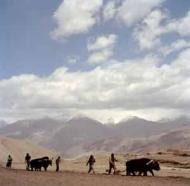WHEN THE INDIAN Prime Minister Manmohan Singh visited Washington in July 2005, a new US–India Knowledge Initiative on Agricultural Education, Teaching, Research, Service and Commercial Linkages was launched. It would be more accurate to call it the Ignorance Initiative. It is based on ignorance of Indian agriculture, it treats the Indian farmer as backward, and it aims at promoting the hazards of genetic engineering. It is ignorant of the ecological and indigenous alternatives that are producing more food while conserving resources.
At a time when the world is recognising the productivity and the ecological sustainability of small farmers, this US–India Agriculture Knowledge Initiative (AKI) is pushing India to adopt hazardous technologies. Instead of learning lessons from the ecological and social non-sustainability of the Green Revolution, the AKI is repeating the mistakes and committing new, more dangerous ones.
LET US LOOK at some of the expert opinions of the past, and what they have to say about Indian agriculture. Nearly a century ago, Sir Albert Howard, the father of modern sustainable farming, wrote in his classic, An Agricultural Testament, that “In the agriculture of Asia we find ourselves confronted with a system of peasant farming which, in essentials, soon became stabilized. What is happening today in the small fields of India and China took place many centuries ago. The agricultural practices of the orient have passed the supreme test, they are almost as permanent as those of the primeval forests, of the prairie, or of the ocean.”
In 1889, Dr John Augustus Voelcker was deputed by the Secretary of State to India to advise the imperial government on the application of agricultural chemistry to Indian agriculture. In his report to the Royal Agricultural Society of England on the improvement of Indian agriculture, Voelcker stated: “To take the ordinary acts of husbandry, nowhere would one find better instances of keeping land scrupulously clean from weeds, of ingenuity in device of water raising appliances, of knowledge of soils and their capabilities as well as of the exact time to sow and to reap as one would in Indian agriculture, and this not at its best only but at its ordinary level. It is wonderful, too, how much is known of rotation, the system of mixed crops and of fallowing. Certain it is that I, at least, have never seen a more perfect picture of careful cultivation combined with hard labour, perseverance and fertility of resource.”
When Western scientists were earlier sent to ‘improve’ Indian agriculture, they found nothing that could be improved in the practices and principles of Indian farming, which were based on preserving and building on nature’s process and patterns. Where Indian agriculture was less productive, it was due not to primitive principles or inferior practices but to interruptions in the flow of resources that made productivity possible. Land alienation, the reservation of forests and the expansion of cash-crop cultivation were among the many factors introduced during colonialism that created a scarcity of local inputs of water and manure to maintain agricultural productivity.
IN THE SECOND quarter of the 20th century, from the First World War until Independence in 1947, Indian agriculture suffered a setback as a consequence of complex factors including worldwide recession, depression, and the paralysis of shipping during the Second World War. The chaos of partition added to its decline, and the expansion of commercial crops like sugar cane and groundnuts pushed food grains onto poorer lands where yields per acre were lower. The upheavals during this period left India faced with a severe food crisis.
There were two responses to this food crisis. The first was indigenous; the second was exogenous. The indigenous response was rooted in the independence movement. It aimed at strengthening the ecological base of agriculture, and the self-reliance of the peasants. The Harijan, a newspaper published by Mahatma Gandhi, was full of articles on how to deal with food scarcity politically, and how to grow more food using internal resources.
At a prayer meeting on 10th June 1947, Gandhi said: “The first lesson we must learn is of self-help and self-reliance. We are not a small place, dependent for its food supply upon outside help. We are a sub-continent, a nation of nearly 400 million. We are a country of mighty rivers and a rich variety of agricultural land, with inexhaustible cattle-wealth … Our country, if it had not been neglected during the past few centuries, should not today only be providing herself with sufficient food, but also be playing a useful role in supplying the outside world with much-needed foodstuffs.”
Recognising that the crisis in agriculture was related to a breakdown of nature’s processes, India’s first agriculture minister, K.M. Munshi, had worked out a detailed strategy on rebuilding and regenerating the ecological base of productivity in agriculture based on bottom-up, decentralised and participatory methods.
In 1951, a programme of regeneration of Indian agriculture was worked out, with the recognition that the diversity of India’s soils, crops and climates had to be taken into account. The need to plan from the bottom, to consider every individual village and sometimes every individual field, was considered essential for the programme called Land Transformation. Working in partnership with nature’s processes was viewed as central to the indigenous agricultural policy.
HOWEVER, WHILE INDIAN scientists and policy-makers were working out self-reliant and ecological alternatives for the regeneration of agriculture in India, another vision of agricultural development was taking shape in the US. This vision was based not on co-operation with nature, but on its conquest; not on the intensification of nature’s processes, but on the intensification of credit and purchased inputs like chemical fertilisers and pesticides; not on self-reliance, but on dependence; not on diversity, but on uniformity. Advisers and experts came from American universities, corporations and the Government to shift India’s agriculture from an indigenous and ecological model to an exogenous and high-input one, finding, of course, partners in sections of the Indian elite, because the new model suited their political priorities.
Politics was built into the Green Revolution because the technologies created were directed at capital-intensive inputs for large and rich farmers in the best-endowed areas, and directed away from resource-prudent options of small farmers in resource-scarce regions. The science and technology of the Green Revolution excluded poor regions and poor people as well as sustainable options.
The AKI is similarly based on a choice to promote the interests of US agribusiness, not those of India’s small farmers. It is a choice to promote a US-style food culture, which has destroyed US family farmers and US health. A country where agribusiness has ensured hazardous food to its own citizens can hardly be expected to provide safe food for India. The AKI is in reality an instrument to destroy India’s diverse local food culture, which guarantees safe and healthy food at low cost.
The real Knowledge Initiative needed in today’s context is a technology transfer from India’s small, biodiverse organic farms and from our small artisan food processors to the US. Traditional Indian farmers could offer some good advice to the US on how to grow healthy and tasty food for all, while putting the least burden on the planet. While the Indian Government will spread GMOs with US corporations, the traditional Indian farmers could offer an organic and careful way of cultivating land. In the true evergreen revolution, nature and farmers come first, not agribusiness. The AKI will spread seeds of ignorance and seeds of homicide by pushing more farmers to suicide. Indian farmers will spread the seeds of freedom and the seeds of life.
QUOTES
The real Knowledge Initiative needed in today’s context is a technology transfer from India’s small, biodiversity organic farms and from our small artisan food processors to the US.
The AKI will spread seeds of ignorance and seeds of homicide by pushing more farmers to suicide. Indian farmers will spread the seeds of freedom and the seeds of life.








